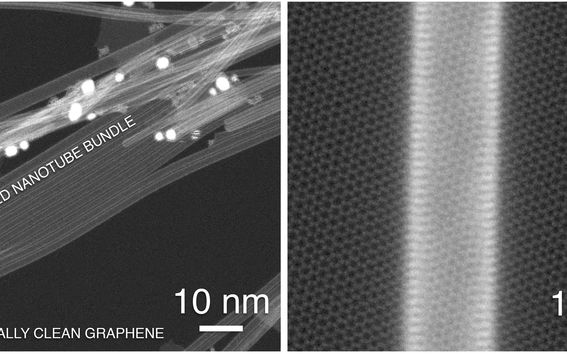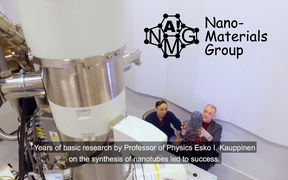Graphene substrate improves the conductivity of carbon nanotube network

Transparent conductive films (TCFs) have many applications in touch screens, organic light emitting diodes and solar cells. These applications need materials that are strong, energy efficient and stable, which is why companies and researchers are interested in carbon-based materials. This applies especially to networks of single-walled carbon nanotubes, which are expected to replace the metal-oxide films that are currently used.
Graphene is the thinnest imaginable material, it is just one atomic layer of carbon atoms. Rolling this into a cylinder makes a carbon nanotube, which is better suited to carrying electricity in real-world applications. In an article published in ACS Nano, scientists at Aalto University and the University of Vienna introduce a hybrid material made by combining carbon nanotubes and graphene, which improves the conductivity of the film beyond what is possible when using each of these component structures separately.
Professor Esko Kauppinen’s group at Aalto has years of experience in making carbon nanotubes for TCFs. This new work applies the techniques they have developed to place densely-packed and clean random nanotube networks on graphene. “This is another application of the technologies we have developed over the past decades. Put simply, this work is about how the two materials are put together without solvents,” Kauppinen explains.
In the study, the scientists used a process called thermophoresis to deposit nanotubes on prefabricated graphene electrodes. The hybrid films’ conductivities were roughly twice as high as predicted.
The experiments conducted by the team at the University of Vienna, led by Jani Kotakoski, showed that the strong electrical interactions of graphene enhanced the flow of electrons between the nanotubes by encouraging charge-tunneling. The team used a scanning transmission electron microscope to look at the material on the scale of individual atoms, and saw that the van der Waals interaction between the graphene and nanotubes was strong enough to collapse the circular nanotube bundles into flat ribbons.
The lead scientist from the Vienna group, Kimmo Mustonen, explains: “This is really an ingenious approach. The charge transport in nanomaterials is very sensitive to any external factors. What you really want is to avoid unnecessary processing steps if your goal is to make the ideal conductive film.” Mustonen adds, “It actually is quite remarkable. We of course knew that the interaction is quite strong. For instance, think of graphite; it is just a large number of graphene layers bound together by the same mechanism. Yet we did not expect that it has such a strong impact on conductivity.”
The results provide opportunities to improve the conductivity of similar hybrid nanomaterials. The article was published in “ACS Nano” in September 2019. You can read the full text here: 10.1021/acsnano.9b05049
Nanomaterials (NMG)
The NanoMaterials Group, headed by Prof. Esko I. Kauppinen, is among the top aerosol technology laboratories in the world and offers a unique environment for strong interdisciplinary research and a proven track record of productive cooperation.

Read more news
Growing Materials, Growing Ideas: Inside the BioMaker Studio
At Aalto University’s BioMaker Studio, initiated by Ena Naito, students and researchers experiment with living materials, from algae to mycelium, creating an open, interdisciplinary space where design, biology, and collaboration grow together.
Your voice gives away valuable personal information, so how do you keep that data safe?
With speech technologies becoming increasingly common, researchers want to make sure we don’t give away more information than we mean to.
Aalto in 2025: Quantum leaps, creative breakthroughs and solutions for a better life
Growth, technology and industrial renewal; human-centred solutions; health and everyday wellbeing; and enjoyable daily life and thriving communities.






